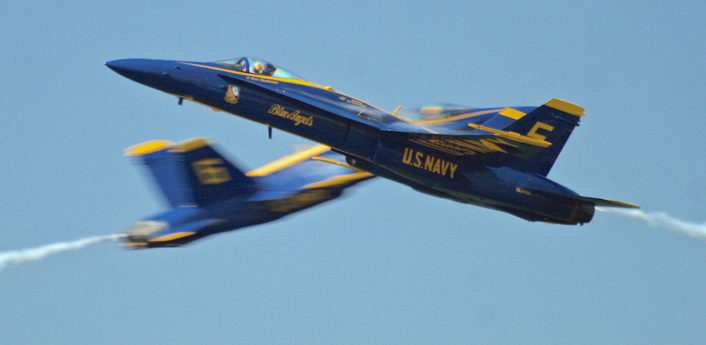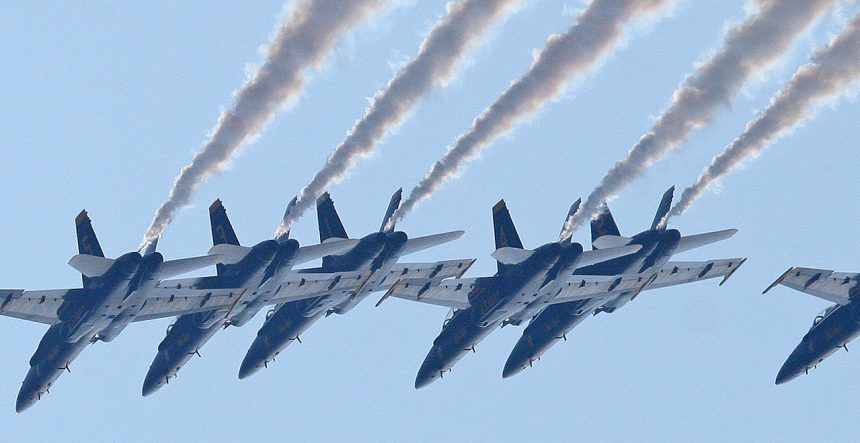Joint Flyover Last Wednesday With USAF Thunderbirds Nearly Ends in Disaster.
A rare joint flyover last Wednesday, Apr. 26, with the U.S. Navy Blue Angels and the U.S. Air Force Thunderbirds nearly ended in calamity when two of the Blue Angels’ F/A-18 Hornets momentarily touched while flying in formation causing minor damage to both aircraft. The two aircraft landed without incident following the collision.
According to a statement released by U.S. Navy Blue Angels spokesperson Lt. Joe Hontz and published in the Navy Times, “Two of the jets in the Blue Angel Delta formation encountered unexpected wake turbulence,” Hontz said, “causing a very brief and minor contact between the aircraft.”
The Blue Angels’ Boeing F/A-18 Hornet aircraft were flying in the six aircraft “delta” formation, an arrowhead arrangement of the four aircraft diamond formation combined with the two solo aircraft flying in outer trailing positions of the four-plane diamond.

The Navy Times reported that Lt. Hontz said, “It is a testament to the training of the pilots that this incident remained very benign. The Blue Angels train in an environment where they fly extremely close — inches away from one another — and are fully prepared to respond and recover should minor contact occur.”
Even a small contact between two combat jets may have catastrophic consequences considered the velocities and energy involved.
An unnamed spokesperson added, “The aircraft required minor maintenance following the ‘paint-swap’ but are currently back in service.” The term “paint swap” was coined in American NASCAR stock car racing to describe when two racecars touch and rub paint onto each other from a minor collision.
The two pilots involved in the incident were not named in official press releases but are reported as cleared to continue flying demonstrations. They performed this past weekend during routine flight demonstrations at the MCAS Beaufort Airshow on April 29-30.
This 2017 incident follows an unusual number of precision jet demonstration team accidents from the same period in 2016 when four crashes on four separate jet teams occurred in only seven days. The U.S. Air Force Thunderbirds, The U.S. Navy Blue Angels, the Swiss Patrouille Suisse team and the Russian Knights all suffered accidents during this time.
Among these, the crash of a Blue Angel F/A-18 during practice for a weekend airshow, took the life of U.S. Marine Captain Jeff Kuss, the Blue Angel number 6 pilot flying in the solo position. An official accident investigation revealed that Capt. Kuss, a highly-experienced FA-18 pilot, had “transitioned from the high-performance climb to the Split S [maneuver] too low and too fast, and by not deselecting his afterburners during the maneuver, he continued to accelerate. The net effect of these deviations was that the aircraft was simply too low and too fast to avoid impacting the ground.”
Hopefully this reportedly minor incident will be the last similar incident for the 2017 season and we will not see a repeated high frequency of accidents this season.
In our story about the fourth incident, we commented: “What’s the odds of four incidents occurring to four display teams in one week? It’s surely an unlucky period.”
Popular Mechanics aviation journalist Kyle Mizokami wrote about the 2016 incidents, “The timing of the four [2016] crashes, all within a seven-day period and two days with two apiece, is a wildly improbable coincidence.”
Update: here’s a video allegedly showing the moment of contact and the “break” between the aircraft: https://www.facebook.com/tim.tisdale.9/videos/10154774271204825/
Image credit: Tom Demerly. Top image shows the U.S. Navy Blue Angels in the “Delta” six-aircraft formation (file photo)









